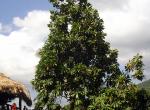disnea
Datura stramonium(en territorios con usos significativos TRAMIL)
Usos tradicionales significativos TRAMIL flor y hoja secas, fumadas1 |
Advertencias Referencias |
De acuerdo con la información disponible: El uso de flor y de hoja secas para crisis de asma y disnea se clasifica como tOxicO (TOX). Dada la toxicidad de las partes aéreas de esta planta, conviene desalentar su uso, independientemente del reconocimiento de las cualidades terapéuticas atribuidas. En caso de intoxicación por ingestión y/o inhalación de las partes aéreas, debe buscar asistencia médica. |
1 WENIGER B, ROUZIER M, 1986 2 ALAMI RR, CHRISTENSEN BV, BEAL JL, 1955 3 HEGNAUER R, 1973 4 SONANINI D, RZADKOWSKA-BODALSKA H, STEINEGGER E, 1970 5 TURSUNOVA R, MASLENNIKOVA V, ABUBAKIROV N, 1976 6 PATE D, AVERETT J, 1986 7 SCHMITZ BOURGEOIS M, AMIRI I, REINBOLT J, BOULANGER Y, UNGERER A, 1988 8 PINKAS M, BEZANGER-BEAUQUESNE L, 1986 9 VINCENT D, LESOBRE R, KAUFMAN E, 1965 10 ITOKAWA H, MIHASHI S, WATANABE K, NATSUMOTO H, HAMANAKA T, 1983 11 FORNO JR FJ, TERRY RA 1998 12 UNGERER A, SCHMITZ-BOURGEOIS M, MELAN C, BOULANGER Y, REINBOLT J, AMIRI I, BARRY J, 1988 13 Hardman JG, Limbird LE, Molinoff PB, Eds., 1996 14 PARRA AL, YHEBRA RS, SARDINAS IG, BUELA LI, 2001 15 KEELER RF, 1981 16 GOTO M, NOGUCHI T, WATANABE T, ISHIKAWA I, KOMATSU M, ARAMAKI Y, 1957 17 HARVEY RB, LARSO AH, LANDON RH, BOYD WL, ERICKSON LC, 1945 18 FERNANDO R, FERNANDO DN, 1990 19 BALLANTYNE A, LIPPIETT P, PARK J, 1976 20 PEREIRA CAL, NISHIOKA SDA, 1994 21 GOWANLOCH JN, BROWN CA, 1943 22 HARRISON EA, MORGAN DH, 1976 23 ODERDA GM, 1975 24 SCHMIDT A, 1943 25 LAMENS D, DE HERT S, VERMEYEN K, 1994 26 SIEGEL RK, 1976 27 GUHAROY SR, BARAJAS M, 1991 28 PARIS R, MOYSE H, 1981 29 CHONKEL A, 1985 30 HARDIN J, ARENA J, 1974 31 TAH S, MAHDI A, 1984 |
|||
Pouteria sapota(en territorios con usos significativos TRAMIL)
Usos tradicionales significativos TRAMIL semilla, machacada, vía oral1 |
Advertencias Referencias |
De acuerdo con la información disponible: El uso de semilla por vía oral se clasifica como TOXICO (TOX). Dada la toxicidad de la semilla de esta planta conviene desalentar su uso por vía oral, independientemente del reconocimiento de las posibles cualidades terapéuticas atribuidas. En caso de intoxicación por ingestión, debe buscar asistencia médica. |
1 GERMOSEN-ROBINEAU L, GERONIMO M, AMPARO C, 1984 Encuesta TRAMIL. enda-caribe, Santo Domingo, Rep. Dominicana. 2 JIU J, 1966 A survey of some medicinal plants of Mexico for selected biological activities. Lloydia29:250-259. 3 MISAS CAJ, HERNANDEZ NMR, ABRAHAM AML, 1979 Contribution of the biological evaluation of Cuban plants. VI. Rev Cub Med Trop 31:45-51. 4 ROJAS HERNANDEZ NM, JIMENEZ MISAS CA, LOPEZ ABRAHAM AM, HERNANDEZ SUAREZ C, 1981 Study of the inhibitory activity of plant extracts on microbial growth. Part V. Rev Cubana Farm 15:139-145. 5 LOPEZ ABRAHAM AN, ROJAS HERNANDEZ NM, JIMENEZ MISAS CA, 1981 Potential antineoplastic activity of Cuban plants. IV. Rev Cubana Farm 15(1):71-77 6 DUKE JM, 1992 Handbook of biologically active phytochemicals and their bioactivities. Boca Raton, USA: CRC Press. 7 POULTON J, KEELER R, TU T (Eds.), 1983 Handbook of natural toxins 1. New York, USA: Marcel Dekker. 8 NAHRSTEDT A, 1987 Recent developments in chemistry, distribution and biology of the cyanogenic glycosides. In: HOSTETTMAN K, LEA, JP (Eds.), Biologically Active Natural Products. Oxford, USA: Oxford Science Publications. pp167-184,213-234. 9 KLAASSEN C, AMDUR D, MARY O, 1986 Toxicology, the basic science of poisons. 3th ed. New York, USA: McMillan Publishing Co. |

